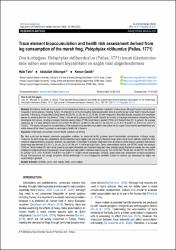Trace element bioaccumulation and health risk assessment derived from leg consumption of the marsh frog, Pelophylax ridibundus (Pallas, 1771)
Citation
Tatlı, H. , Altunışık, A. & Gedik, K. (2022). Trace element bioaccumulation and health risk assessment derived from leg consumption of the marsh frog, Pelophylax ridibundus (Pallas, 1771). Ege Journal of Fisheries and Aquatic Sciences, 39 (3), 182-190. https://doi.org/10.12714/egejfas.39.3.02Abstract
Amphibians, which can live in aquatic and terrestrial environments, are a good indicator of pollution in these areas. Although frog leg is not consumed frequently in some cuisines, including Turkey, it is important in terms of evaluating metal accumulation since it is preferred as human food in many European countries. In this study, the quantities of trace elements (Cd, Pb, Cu, Zn, As, Co, Cr, Ni, Mn, V) were measured in the edible tissues (muscles) of an amphibian species by sampling from two frog farms in Turkey. It was aimed to assess possible health hazards for humans by frog legs consumption comparing with the toxicological limit values, including provisional tolerable weekly intake (PTWI), target hazard quotient (THQ), and Hazard Index (HI). In general, the average values (mu g kg(-1)) of trace elements were Zn (3.437.62)> Pb (69.22)> Cu (66.72)> Mn (35.07)> As (24.24)> Cr (11.47)> Ni (6.94)> Cd (6.51)> Co (2.97)> V (<0.001). The results indicated that concentrations of the analyzed trace elements were determined below the European Commission's permitted levels and edible tissues of the marsh frog posed no carcinogenic health risk to humans.


















